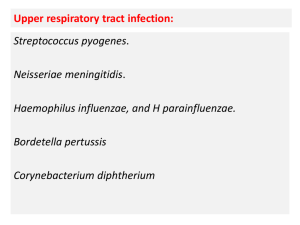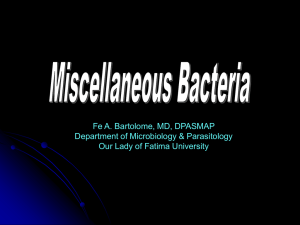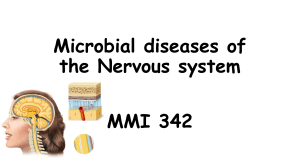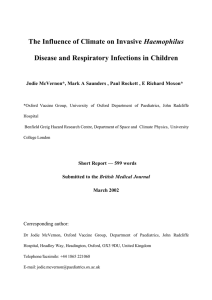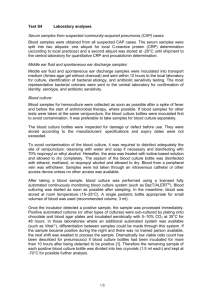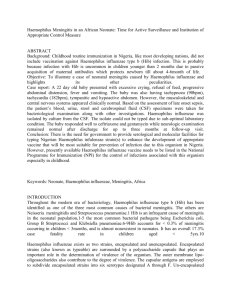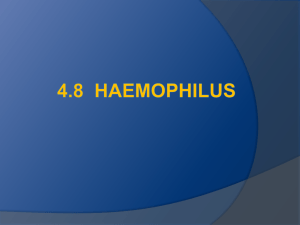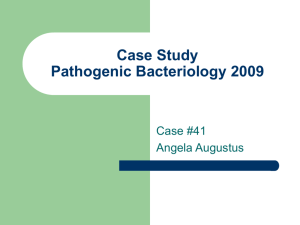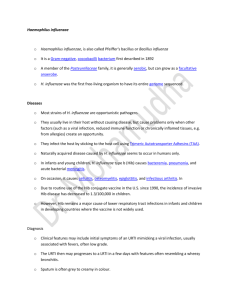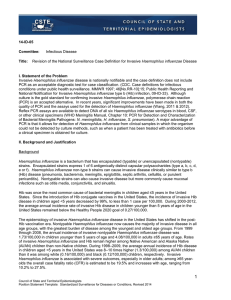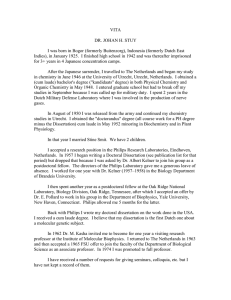Haemophilus
advertisement
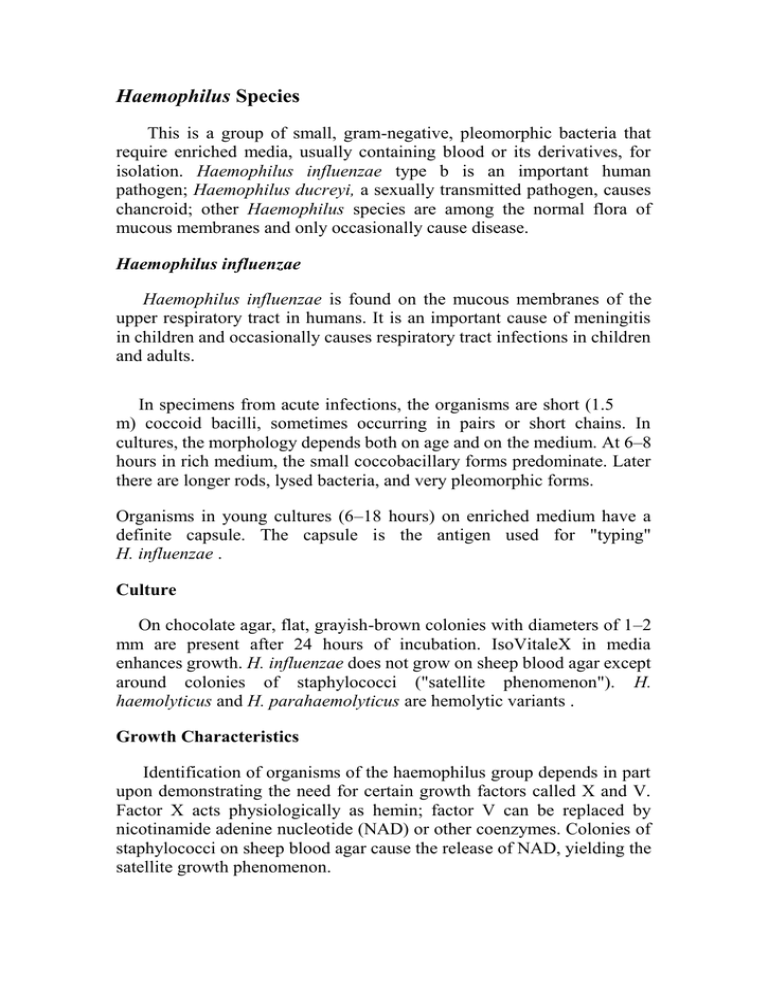
Haemophilus Species This is a group of small, gram-negative, pleomorphic bacteria that require enriched media, usually containing blood or its derivatives, for isolation. Haemophilus influenzae type b is an important human pathogen; Haemophilus ducreyi, a sexually transmitted pathogen, causes chancroid; other Haemophilus species are among the normal flora of mucous membranes and only occasionally cause disease. Haemophilus influenzae Haemophilus influenzae is found on the mucous membranes of the upper respiratory tract in humans. It is an important cause of meningitis in children and occasionally causes respiratory tract infections in children and adults. In specimens from acute infections, the organisms are short (1.5 m) coccoid bacilli, sometimes occurring in pairs or short chains. In cultures, the morphology depends both on age and on the medium. At 6–8 hours in rich medium, the small coccobacillary forms predominate. Later there are longer rods, lysed bacteria, and very pleomorphic forms. Organisms in young cultures (6–18 hours) on enriched medium have a definite capsule. The capsule is the antigen used for "typing" H. influenzae . Culture On chocolate agar, flat, grayish-brown colonies with diameters of 1–2 mm are present after 24 hours of incubation. IsoVitaleX in media enhances growth. H. influenzae does not grow on sheep blood agar except around colonies of staphylococci ("satellite phenomenon"). H. haemolyticus and H. parahaemolyticus are hemolytic variants . Growth Characteristics Identification of organisms of the haemophilus group depends in part upon demonstrating the need for certain growth factors called X and V. Factor X acts physiologically as hemin; factor V can be replaced by nicotinamide adenine nucleotide (NAD) or other coenzymes. Colonies of staphylococci on sheep blood agar cause the release of NAD, yielding the satellite growth phenomenon. Table 19–1. Characteristics and Growth Requirements of the Haemophilus Species Important to Humans. (X = Heme; V = Nicotinamide-Adenine Dinucleotide.) Requires Species X V Hemolysis H influenzae (H aegyptius) + + - H parainfluenzae - + - H ducreyi + - - H haemolyticus + + + H parahaemolyticus - + + H aphrophilus - - - H paraphrophilus - + - H paraphrophaemolyticus - + + H segnis - + - Variation In addition to morphologic variation, H. influenzae has a marked tendency to lose its capsule and the associated type specificity. Nonencapsulated variant colonies lack iridescence. Antigenic Structure Encapsulated H. influenzae contains capsular polysaccharides one of six types (a–f). The capsular antigen of type b is a polyribose-ribitol phosphate (PRP). Encapsulated H. influenzae can be typed by slide agglutination, coagglutination with staphylococci . A capsule swelling test with specific antiserum is analogous to the quellung test for pneumococci. Typing can also be done by immunofluorescence. The somatic antigens of H. influenzae consist of outer membrane proteins. Lipooligosaccharides (endotoxins) . Pathogenesis H. influenzae produces no exotoxin. The nonencapsulated organism is a regular member of the normal respiratory flora of humans. The capsule is antiphagocytic in the absence of specific anticapsular antibodies. The polyribose phosphate capsule of type b H. influenzae is the major virulence factor. Type b H. influenzae causes meningitis, pneumonia and empyema, epiglottitis, cellulitis, septic arthritis, and occasionally other forms of invasive infection. Nontypeable H. influenzae tends to cause chronic bronchitis, otitis media, sinusitis, and conjunctivitis following breakdown of normal host defense mechanisms. Although type b can cause chronic bronchitis, otitis media, sinusitis, and conjunctivitis. Clinical Findings H. influenzae type b enters by way of the respiratory tract. There may be local extension with involvement of the sinuses or the middle ear. H. influenzae type b and pneumococci are two of the most common etiologic agents of bacterial otitis media and acute sinusitis. The organisms may reach the bloodstream and be carried to the meninges or, less frequently, may establish themselves in the joints to produce septic arthritis. Prior to the use of the conjugate vaccine, H. influenzae was the most common cause of bacterial meningitis in children age 5 months to 5 years in the United States. Clinically, it resembles other forms of childhood meningitis. Diagnostic Laboratory Tests Specimens Specimens consist of nasopharyngeal swabs, pus, blood, and spinal fluid for smears and cultures. Culture Specimens are grown on IsoVitaleX-enriched chocolate agar until typical colonies appear. H. influenzae is differentiated from related gramnegative bacilli by its requirements for X and V factors and by its lack of hemolysis on blood agar . Tests for X (heme) and V (nicotinamide-adenine dinucleotide) factor requirements can be done in several ways. The Haemophilus species that require V factor grow around paper strips or disks containing V factor placed on the surface of agar that has been autoclaved before the blood was added (V factor is heat-labile). Alternatively, a strip containing X factor can be placed in parallel with one containing V factor on agar deficient in these nutrients. Growth of Haemophilus in the area between the strips indicates requirement for both factors. A better test for X factor requirement is based on the inability of H. influenzae to synthesize heme . Immunity Infants under age 3 months may have serum antibodies transmitted from the mother. During this time H. influenzae infection is rare, but subsequently the antibodies are lost. Children often acquire H. influenzae infections, which are usually asymptomatic but may be in the form of respiratory disease or meningitis. H. influenzae has been the most common cause of bacterial meningitis in children from 5 months to 5 years of age. By age 3–5 years, many unimmunized children have naturally acquired anti-PRP antibodies that promote complementdependent bactericidal killing and phagocytosis. Immunization of children with H. influenzae type b conjugate vaccine induces the same antibodies. Treatment Essentially all strains are susceptible to the third-generation cephalosporins. Cefotaxime given intravenously gives excellent results. Epidemiology, Prevention, & Control Encapsulated H. influenzae type b is transmitted from person to person by the respiratory route. H. influenzae type b disease can be prevented by administration of Haemophilus b conjugate vaccine to children.
